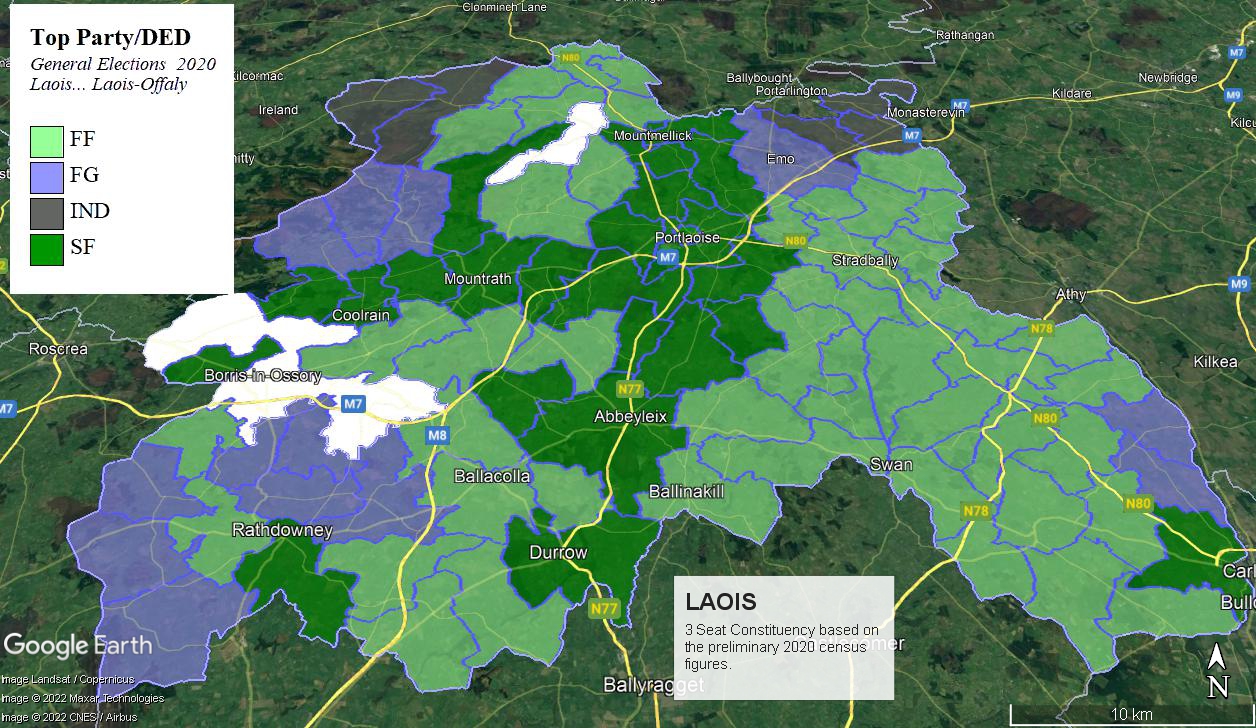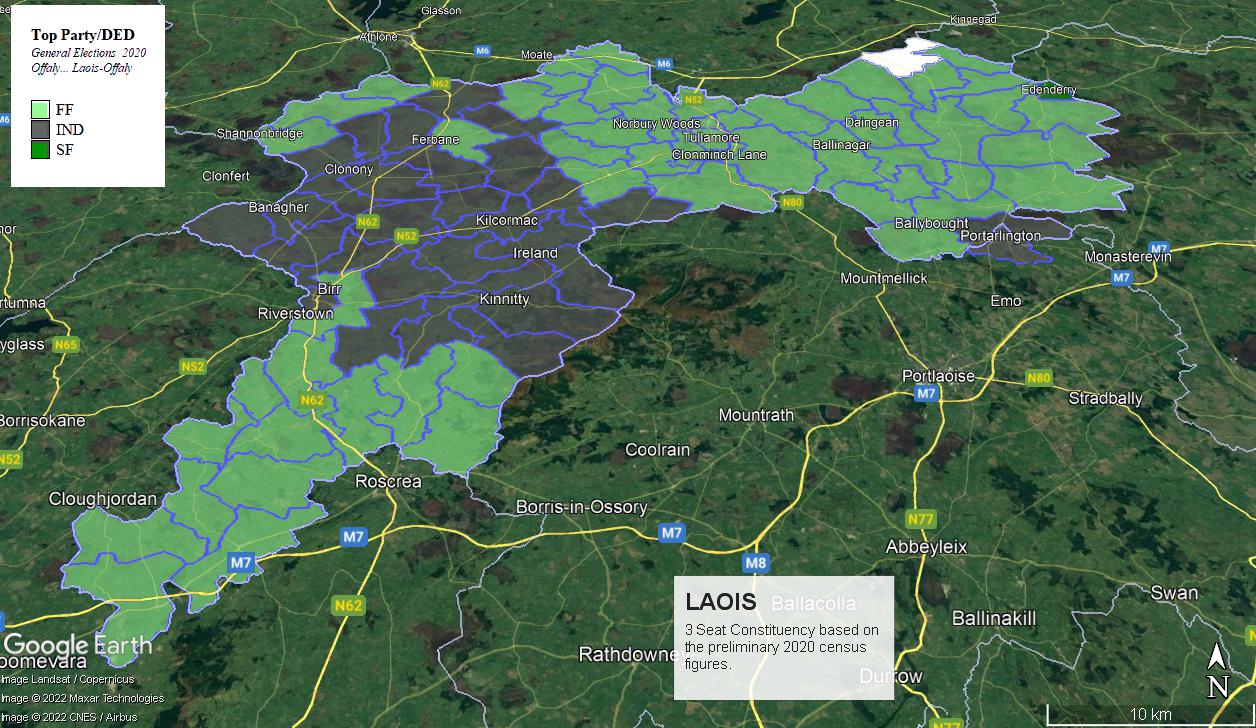The following workings are based on the preliminary results from the 2022 census.
I was originally going to work solely on the basis of a 171 seat Dail – but based on Adrian Kavanagh’s post regarding what a Boundary Commission might be likely to do, I’m instead going to concentrate on a 176 seat Dáil.
SCENARIO A – A 176 SEAT DAIL
The Counties of Laois and Offaly combined have a population of 174,325 souls which – under Scenario A – would entitle them jointly to 6 seats (5.99 seats based on Population divided by ratio of number of people per Dail Seat).
However, while Laois (entitled to just under 3.15 seats, therefore just within the maximum allowed deviation) could be a standalone constituency, Offaly (entitled to 2.84 seats) is just outside the maximum permitted variance. This can be easily remedied by a transfer of population from Laois to Offaly.
The most obvious Electoral Division is Portarlington South which contains the roughly two-thirds of Portarlington town which lies south of the Laois-Offaly border (Whatever bright spark in bygone days decided to situate Portarlington straddling the border of two counties clearly did not have the interests of future political cartographers and boundary commissioners foremost in their minds).
TABLE 1 – LAOIS AND OFFALY POPULATION RATIO
| Dail Size | Number of seats | Deviation | ||
| LAOIS | OFFALY | LAOIS | OFFALY | |
| 171 | 3.06 | 2.76 | +2.0% | -8.0% |
| 176 | 3.15 | 2.84 | +5.0% | -5.3% |
| 181 | 3.24 | 2.92 | +7.9% | -2.7% |
Transferring Portarlington South into the Offaly constituency involves a population shift of 7,856 souls and would see both constituencies within the permitted variation limit as well as the town of Portarlington being reunited.
Taking Laois first, the constituency consists of the whole of Laois except South Portarlington which moves into the Offaly constituency. The village of Ballybrittas and surrounding areas moves back in from the Kildare South Constituency.
TABLE 1 – THE NEW LAOIS (3 seats)
| Party | 2020 Vote | Transfer from Kildare South | New Constituency | |||
| SF | 9442 | 31.7% | 217 | 22.6% | 9659 | 31.4% |
| FF | 8780 | 29.5% | 153 | 16.0% | 8933 | 29.1% |
| FG | 6254 | 21.0% | 133 | 13.9% | 6387 | 20.8% |
| LAB | 1528 | 5.1% | 33 | 3.4% | 1561 | 5.1% |
| GP | 1474 | 4.9% | 36 | 3.8% | 1510 | 4.9% |
| S-P | 507 | 1.7% | 8 | 0.8% | 515 | 1.7% |
| IDP | 258 | 0.9% | 0.0% | 258 | 0.8% | |
| NP | 257 | 0.9% | 0.0% | 257 | 0.8% | |
| REN | 189 | 0.6% | 0.0% | 189 | 0.6% | |
| SD | 0 | 0.0% | 20 | 2.1% | 15 | 0.0% |
| AON | 0 | 0.0% | 17 | 1.8% | 14 | 0.0% |
| IND | 1100 | 3.7% | 342 | 35.7% | 1442 | 4.7% |
The small transfer of population from the Kildare South constituency makes no material difference to the potential outcome of the vote in a three-seat Laois constituency on the 2020 figures – it would be a straightforward divvy-up of one seat each for Fianna Fáil, Fine Gael and Sinn Féin.

Unfortunately, it’s not strictly possible to directly look at socio-economic bases of support in largely rural constituencies as many of the towns only occupy 1 or 2 Electoral Divisions – and although socio-economic data is available for SAPs (Small Area Packets), again unfortunately these are not referenced in polling schemes.
However, we can look at support by settlement size – Laois has one large town (Portlaoise), several small towns (Mountmellick, Graiguecullen, Mountrath and Abbeyleix) as well as multiple villages and hamlets.
TABLE 3 – LAOIS PARTY SUPPORT BY SETTLEMENT SIZE
| PARTY | Large and Medium Towns | Small Towns and Villages | Hamlets and Rural areas |
| Urban Pop. | 5k+ | 0.5k-5k | Under 0.5k |
| SF | 36% | 33% | 26% |
| FF | 23% | 27% | 36% |
| FG | 18% | 20% | 24% |
| Others | 22% | 12% | 11% |
| IND | 2% | 8% | 3% |
| Proportion | 25% | 41% | 34% |
Just over half the voters lived in villages, hamlets and rural areas, one fifth lived in small towns, and the remaining quarter in Portlaoise.
As can be seen, there is a definite correlation between settlement size and Party support particularly for Fianna Fáil and Sinn Féin. The Labour candidate polled respectably in Portlaoise but failed to spark elsewhere. Interestingly, the Green Party seems to have polled as well in rural areas as they did in Urban.
Turning to Offaly, the 3-seat Offaly constituency would consist of the whole county plus the southside of Portarlington.
TABLE 4 – THE NEW OFFALY (3 seats)
| Party | Vote 2020 | Transfer from North Portarlington | Transfer from South Portarlington | New Constituency | ||||
| SF | 5992 | 17.2% | 271 | 28.5% | 744 | 29.9% | 7007 | 18.3% |
| FF | 11888 | 34.1% | 120 | 12.6% | 281 | 11.3% | 12289 | 32.1% |
| FG | 4735 | 13.6% | 61 | 6.4% | 184 | 7.4% | 4980 | 13.0% |
| GP | 1760 | 5.1% | 18 | 1.9% | 63 | 2.5% | 1841 | 4.8% |
| LAB | 233 | 0.7% | 8 | 0.8% | 50 | 2.0% | 291 | 0.8% |
| SP | 302 | 0.9% | 9 | 0.9% | 32 | 1.3% | 343 | 0.9% |
| IDP | 2203 | 6.3% | 0 | 0.0% | 0 | 0.0% | 2203 | 5.8% |
| NP | 144 | 0.4% | 0 | 0.0% | 0 | 0.0% | 144 | 0.4% |
| REN | 68 | 0.2% | 0 | 0.0% | 0 | 0.0% | 68 | 0.2% |
| SD | 0 | 0.0% | 10 | 1.1% | 38 | 1.5% | 48 | 0.1% |
| AON | 0 | 0.0% | 16 | 1.7% | 39 | 1.6% | 55 | 0.1% |
| IND | 7507 | 21.6% | 437 | 46.0% | 1056 | 42.5% | 9000 | 23.5% |
The one sure seat in Offaly is Barry Cowen’s on these numbers with the other two seats between an Offaly Sinn Féin candidate, Marcella Corcoran-Kennedy of Fine Gael and Independent TD Carol Nolan.

Fine Gael has the lowest vote total, and Corcoran-Kennedy’s task is further complicated by the fact that a quarter of the Offaly Fine Gael vote went to Charlie Flanagan.
Carol Nolan TD got a relatively modest first-preference vote, but proved to be very transfer friendly, in particular taking over half of Independent John Leahy’s transfers – in 2016, when she was a Sinn Féin candidate and he was in Renua she secured just under a quarter of his transfers.
It would seem most likely that Nolan and whoever the Sinn Féin candidate is would take the other two seats.
TABLE 4 – OFFALY PARTY SUPPORT BY SETTLEMENT SIZE
| PARTY | Large and Medium Towns | Small Towns and Villages | Hamlets and Rural areas |
| Urban Pop. | 5k+ | 0.5k-5k | Under 0.5k |
| SF | 26% | 16% | 14% |
| FF | 24% | 35% | 36% |
| FG | 11% | 12% | 15% |
| GP | 6% | 4% | 5% |
| LAB | 1% | 1% | 1% |
| SP | 1% | 1% | 1% |
| IDP | 8% | 5% | 3% |
| IND | 21% | 26% | 23% |
| Proportion | 30% | 29% | 40% |
Finally, the Offaly constituency would be broadly similar to Laois in terms of its composition – and indeed a similar pattern can be seen where Fianna Fáil attracts greater support in the rural areas and Sinn Féin greater support in the towns.